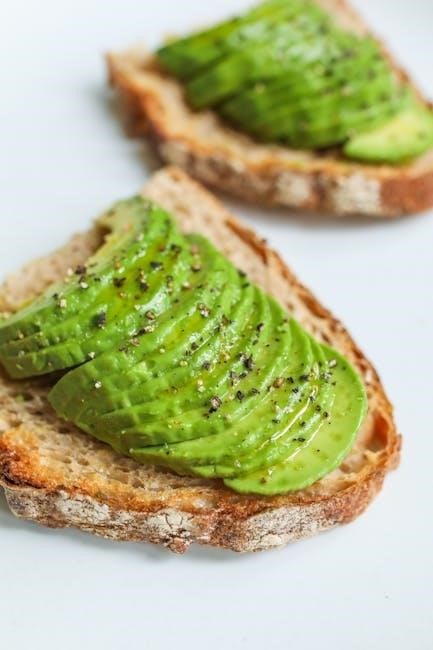The SIBO diet focuses on managing symptoms of small intestinal bacterial overgrowth by reducing FODMAPs and harmful bacteria. A structured food list helps identify safe‚ symptom-relieving options‚ promoting better digestion and overall well-being.
What is SIBO and How Does Diet Impact It?
Small Intestinal Bacterial Overgrowth (SIBO) is a condition characterized by an abnormal increase in bacteria within the small intestine‚ leading to symptoms like bloating‚ abdominal pain‚ diarrhea‚ and malabsorption. Diet plays a crucial role in managing SIBO‚ as certain foods can trigger or alleviate symptoms. High-FODMAP foods‚ which are fermented by gut bacteria‚ are particularly problematic. A low-FODMAP diet is often recommended to reduce bacterial fermentation and alleviate discomfort. By eliminating high-FODMAP foods and focusing on low-FODMAP alternatives‚ individuals can create a gut environment less favorable to bacterial overgrowth. The SIBO diet aims to balance nutrition while minimizing symptoms‚ emphasizing the importance of personalized food choices to support gut health and overall well-being.
The Importance of a Food List for SIBO Management
A food list is essential for managing SIBO‚ as it provides clear guidance on which foods to eat and avoid. By categorizing foods into low- and high-FODMAP groups‚ individuals can make informed choices to reduce symptoms like bloating and discomfort. The list helps identify safe‚ easily digestible options while eliminating triggers. It also ensures nutritional balance‚ preventing malnutrition from overly restrictive eating. Over time‚ the list serves as a tool for reintroducing foods‚ helping patients understand their tolerance levels. A well-structured food list empowers individuals to take control of their diet‚ fostering confidence and long-term symptom management. It’s a cornerstone of SIBO treatment‚ offering a personalized approach to healing and maintaining gut health.

Understanding the SIBO Diet
The SIBO diet is a structured approach to managing bacterial overgrowth by limiting FODMAPs and other triggers‚ promoting a balanced intake of proteins‚ fats‚ fruits‚ vegetables‚ and grains.
Key Principles of the SIBO Diet
The SIBO diet focuses on managing bacterial overgrowth by adjusting dietary intake. It emphasizes eliminating high-FODMAP foods‚ which are poorly absorbed and can feed harmful bacteria. The diet also avoids processed foods‚ artificial additives‚ and sugar alcohols‚ which can exacerbate symptoms. Instead‚ it promotes the consumption of whole‚ nutrient-rich foods like lean proteins‚ healthy fats‚ and low-FODMAP fruits and vegetables. A structured food list is essential for identifying safe options and ensuring adherence. The diet often follows a phased approach‚ starting with a strict elimination period before gradually reintroducing foods. This method helps identify triggers and tailor the diet to individual needs. By focusing on gut-friendly foods and avoiding irritants‚ the SIBO diet aims to reduce bacterial overgrowth‚ alleviate symptoms‚ and improve overall digestive health. Consultation with a healthcare provider or dietitian is recommended for personalized guidance.
How the SIBO Diet Differs from Other Diets
The SIBO diet is distinct from other diets in its primary objective of managing bacterial overgrowth in the small intestine. Unlike keto or paleo diets‚ which focus on macronutrient balance or eliminating grains‚ the SIBO diet centers on reducing FODMAPs and certain carbohydrates. It avoids high-FODMAP foods‚ sugar alcohols‚ and processed additives that can feed harmful bacteria. While other diets may allow moderate amounts of these‚ the SIBO diet strictly limits them to alleviate symptoms like bloating and abdominal pain. Additionally‚ it often incorporates a structured elimination and reintroduction phase‚ which is more specific than general low-carb or gluten-free approaches. The SIBO diet’s tailored food list ensures it targets gut health uniquely‚ making it different from broader dietary plans. This focus on gut microbiome balance sets it apart from more general wellness-focused diets.
The Role of FODMAPs in SIBO Management
FODMAPs (Fermentable Oligosaccharides‚ Disaccharides‚ Monosaccharides‚ and Polyols) play a central role in SIBO management. These short-chain carbohydrates are poorly absorbed in the gut and can be fermented by bacteria‚ exacerbating symptoms like bloating and abdominal pain. By reducing high-FODMAP foods‚ the SIBO diet aims to starve harmful bacteria‚ alleviating digestive discomfort. The initial phase of the diet focuses on eliminating high-FODMAP foods‚ such as certain fruits‚ vegetables‚ dairy products‚ and processed foods. Over time‚ individuals can reintroduce FODMAPs one at a time to identify personal tolerances. This structured approach helps manage bacterial overgrowth and restores gut balance. Understanding FODMAPs is essential for creating a personalized SIBO diet plan‚ as sensitivity to these compounds varies widely among individuals. The goal is to minimize symptoms while maintaining a diverse and nutritious diet.

Food Categories in the SIBO Diet
The SIBO diet organizes foods into categories like proteins‚ fats‚ fruits‚ vegetables‚ grains‚ dairy‚ and nuts/seeds‚ each with specific guidelines to minimize FODMAPs and bacterial overgrowth.
Allowed Foods: Proteins
Proteins play a crucial role in the SIBO diet‚ providing essential nutrients without triggering symptoms. Lean meats like chicken‚ turkey‚ and fish are excellent choices‚ as they are naturally low in FODMAPs. Beef and pork can also be included‚ but it’s important to opt for unprocessed cuts to avoid hidden additives. Eggs are another versatile and easily digestible protein source. For plant-based options‚ tofu and tempeh are generally well-tolerated‚ though portion control is key. Organ meats‚ like liver‚ are also allowed in moderation. Ensuring that all protein sources are fresh and free from marinades or seasonings high in FODMAPs will help maintain a symptom-free diet. This category offers a wide variety of options‚ making it easy to incorporate into meals while managing SIBO effectively.
Allowed Foods: Fats
Fats are an essential component of the SIBO diet‚ providing energy and supporting digestion. Healthy fats like olive oil‚ coconut oil‚ and avocado oil are excellent choices‚ as they are low in FODMAPs and easy to tolerate. Butter and ghee are also permitted‚ as they are lactose-free and less likely to cause discomfort. Fatty fish‚ such as salmon and mackerel‚ are rich in omega-3 fatty acids and can be included in moderation. When using fats‚ it’s important to avoid processed or hydrogenated options‚ as they may contain harmful additives. Additionally‚ portion control is key‚ as excessive fat intake can sometimes exacerbate symptoms. By incorporating these fats into your meals‚ you can add flavor and nutrition while maintaining a balanced SIBO-friendly diet.
Allowed Foods: Fruits
Certain fruits are recommended on the SIBO diet due to their low FODMAP content and gentle digestion properties. Bananas‚ berries (such as strawberries‚ blueberries‚ and raspberries)‚ and citrus fruits like oranges and grapefruits are excellent choices. Kiwis and pineapples are also allowed in moderation. These fruits are rich in vitamins‚ antioxidants‚ and fiber‚ making them nutritious additions to meals. However‚ portion sizes should be controlled to avoid triggering symptoms. Fruits like apples‚ pears‚ and watermelon should be avoided in the initial phase due to their high FODMAP content. Incorporating the right fruits can help manage symptoms while providing essential nutrients. Always refer to a comprehensive SIBO food list for specific guidance and portion recommendations to ensure optimal symptom control and balanced nutrition.
Allowed Foods: Vegetables
Vegetables play a crucial role in the SIBO diet‚ offering essential nutrients while minimizing digestive discomfort. Low-FODMAP vegetables are ideal‚ as they are less likely to trigger symptoms. Cucumber‚ zucchini‚ and bell peppers are excellent choices‚ as they are gentle on the digestive system. Leafy greens like spinach‚ kale‚ and lettuce are also permitted in moderation. Carrots‚ green beans‚ and bok choy are additional options that are well-tolerated. It’s important to avoid high-FODMAP vegetables such as garlic‚ onions‚ broccoli‚ and cauliflower during the initial phase. Cooking and peeling vegetables can reduce their FODMAP content‚ making them more suitable for the diet. Always refer to a comprehensive SIBO food list to ensure proper portion sizes and safe options. Incorporating these vegetables can help maintain a balanced diet while managing SIBO symptoms effectively.
Allowed Foods: Grains
Grains can be part of a SIBO-friendly diet when chosen carefully. Rice‚ quinoa‚ and gluten-free oats are excellent low-FODMAP options that are easy to digest. These grains provide sustained energy and fiber without triggering symptoms. Certified gluten-free bread and pasta made from rice‚ corn‚ or quinoa are also permitted. However‚ it’s important to avoid high-FODMAP grains like wheat‚ rye‚ and barley‚ as well as products containing gluten‚ which can exacerbate symptoms. Small portions of ancient grains like millet and sorghum are generally well-tolerated. Always opt for unprocessed‚ whole grains to minimize additives and ensure compatibility with the SIBO diet. Consulting a SIBO food list can help identify safe grain options and portion sizes‚ making meal planning easier and more effective for managing symptoms.
Allowed Foods: Dairy
Dairy options for SIBO must be chosen mindfully to avoid triggering symptoms. Lactose-free milk‚ almond milk‚ and rice milk are excellent low-FODMAP choices‚ providing essential nutrients without discomfort. Hard cheeses like cheddar‚ Swiss‚ and parmesan are typically well-tolerated due to their low lactose content. Small portions of yogurt‚ especially lactose-free or coconut-based varieties‚ can also be included. Soft cheeses like brie and feta are generally safe in moderation. However‚ high-lactose dairy products like regular milk‚ cream‚ and soft cheeses should be avoided. Additionally‚ many find plant-based alternatives‚ such as almond yogurt‚ to be gentle on the digestive system. Always refer to a comprehensive SIBO food list to ensure dairy choices align with your dietary needs and symptom management goals.
Allowed Foods: Nuts and Seeds
Nuts and seeds can be a healthy addition to the SIBO diet when chosen carefully. Almonds‚ walnuts‚ and pumpkin seeds are excellent options‚ provided they are consumed in small portions (1-2 tablespoons or 10-12 nuts per serving). Sunflower seeds‚ chia seeds‚ and flaxseeds are also tolerated by many. However‚ portion control is crucial‚ as overconsumption can trigger symptoms. It’s important to opt for unsweetened and unflavored varieties to avoid hidden FODMAPs or additives. Psyllium husks‚ often used for fiber‚ are generally well-tolerated but should be introduced gradually. Always refer to a detailed SIBO food list to ensure compliance with your dietary plan. Nuts and seeds provide healthy fats and fiber‚ making them a valuable part of a balanced SIBO-friendly diet when consumed mindfully.

Foods to Avoid on the SIBO Diet
High-FODMAP foods‚ processed items‚ and sugar alcohols like sorbitol‚ isomalt‚ and mannitol should be eliminated to reduce symptoms and promote gut health effectively.
High-FODMAP Foods to Eliminate
Common high-FODMAP foods include beans‚ lentils‚ onions‚ garlic‚ broccoli‚ cauliflower‚ and certain fruits like apples and pears. Among dairy products‚ lactose-containing milk and soft cheeses are problematic. Processed foods with added sugars‚ such as sorbitol‚ mannitol‚ and xylitol‚ should also be avoided. These foods can trigger bloating‚ abdominal pain‚ and other SIBO symptoms. Eliminating them helps reduce bacterial fermentation in the gut‚ providing relief. A comprehensive food list is essential to identify and remove these items effectively. By focusing on low-FODMAP alternatives‚ individuals can manage symptoms and improve digestion. Always refer to a reliable SIBO food list PDF for detailed guidance on what to avoid.
Processed Foods and Additives to Avoid
Processed foods and certain additives are detrimental to SIBO management. These include items like sugary snacks‚ ready-to-eat meals‚ and condiments with hidden FODMAPs. Artificial sweeteners like sorbitol‚ mannitol‚ and xylitol‚ often found in sugar-free gums and candies‚ are particularly problematic. Additionally‚ many processed foods contain high-fructose corn syrup and inulin‚ which can exacerbate symptoms. Preservatives and flavor enhancers‚ such as MSG‚ may also contribute to gut discomfort. It’s crucial to read food labels and avoid products with these additives. Opting for whole‚ unprocessed foods is a safer choice. A detailed SIBO food list PDF can help identify and eliminate these problematic ingredients‚ aiding in symptom relief and promoting a healthier digestive environment.
Sugar Alcohols and Their Impact on SIBO
Sugar alcohols‚ such as sorbitol‚ mannitol‚ and xylitol‚ are commonly found in sugar-free products but can significantly worsen SIBO symptoms. These substances are poorly absorbed in the small intestine‚ leading to bloating‚ gas‚ and diarrhea. They act as fermentable substrates‚ feeding the overgrown bacteria in the gut‚ which exacerbates symptoms. Many processed foods‚ including sugar-free gums‚ candies‚ and diet products‚ contain these alcohols. It’s essential to avoid them during the initial phases of the SIBO diet. A comprehensive SIBO food list PDF can help identify products containing sugar alcohols‚ ensuring they are eliminated from the diet. By removing these triggers‚ individuals can better manage their symptoms and promote a balanced gut environment. Awareness of hidden sources of sugar alcohols is key to effectively following the SIBO diet and achieving symptom relief.

Practical Tips for Following the SIBO Diet

Find a Reliable Food List: Obtain a comprehensive SIBO food list PDF to identify allowed and avoided foods‚ ensuring clarity on dietary choices.
Eliminate High-FODMAP Foods: Start by cutting out known high-FODMAP ingredients like garlic and onions to reduce digestive discomfort.
Avoid Sugar Alcohols: Reduce or eliminate sugar-free products containing sorbitol‚ mannitol‚ and xylitol‚ which can exacerbate symptoms.
Meal Planning: Discover simple‚ SIBO-friendly recipes to maintain variety and nutrition without complicating cooking routines.
Grocery Shopping Strategies: Learn to read food labels to identify and avoid high-FODMAP ingredients‚ aiding in effective grocery shopping.
Reintroduction Process: Gradually reintroduce foods one at a time after the initial phase‚ monitoring for any adverse symptoms to identify triggers.
Stay Informed and Seek Support: Utilize online resources for recipes and tips‚ and consider consulting a dietitian for personalized advice to overcome challenges.
By implementing these practical steps‚ managing SIBO through dietary changes becomes more manageable and sustainable.
How to Use the SIBO Food List Effectively
Using a SIBO food list effectively begins with identifying and eliminating high-FODMAP foods that trigger symptoms. Start by focusing on the elimination phase‚ removing concentrated sources like garlic‚ onions‚ and certain grains. Next‚ incorporate SIBO-friendly options such as lean proteins‚ low-FODMAP vegetables‚ and gluten-free grains. Gradually reintroduce foods one at a time to identify personal triggers. Keep track of symptoms and adjustments in a food diary for clarity. Consult a healthcare provider or dietitian for personalized guidance‚ especially when reintroducing foods. Finally‚ use online resources or a SIBO food list PDF to discover recipes and meal ideas that align with your dietary needs. By systematically applying the food list‚ you can manage symptoms effectively and improve digestive health.
Meal Planning and Grocery Shopping Strategies
Meal planning is essential for adhering to the SIBO diet‚ as it ensures you only consume approved foods. Start by creating a weekly meal schedule‚ focusing on SIBO-friendly ingredients like lean proteins‚ low-FODMAP vegetables‚ and gluten-free grains. Plan breakfast‚ lunch‚ and dinner options in advance to avoid last-minute decisions that may lead to non-compliant choices. When grocery shopping‚ refer to your SIBO food list PDF to identify safe options. Stock up on essentials like fresh vegetables‚ lean meats‚ and low-FODMAP condiments. Avoid processed foods and high-FODMAP additives by reading labels carefully. Consider batch cooking to save time and ensure meals are readily available. By organizing your meals and shopping strategically‚ you can maintain consistency and reduce symptom flare-ups effectively.
Reintroducing Foods After the Initial Phase
Reintroducing foods after the initial phase of the SIBO diet is a gradual process aimed at identifying tolerable foods while minimizing symptom recurrence. Begin with small portions of one food at a time‚ such as a low-FODMAP vegetable or a single grain‚ and monitor for any adverse reactions. Keep a symptom journal to track changes. This step helps determine which foods can be safely incorporated into your long-term diet. Prioritize nutrient-dense options like whole grains‚ lean proteins‚ and vegetables. Avoid rushing the process‚ as this can trigger symptoms. Consulting a healthcare provider or dietitian is crucial to guide reintroduction safely. Over time‚ this phase helps broaden your diet while maintaining SIBO management. Patience is key to achieving a balanced and sustainable eating plan tailored to your needs.

Additional Resources
Download a comprehensive SIBO food list PDF for easy reference. Consult a healthcare provider for personalized guidance and tailored meal plans to manage your condition effectively.
Where to Find a Comprehensive SIBO Food List PDF
A comprehensive SIBO food list PDF can be found on trusted websites specializing in gut health or through healthcare providers. Official SIBO resources‚ medical websites‚ and dietary platforms often offer downloadable guides. Search for “SIBO diet food list PDF” on trusted search engines to find the latest versions. Additionally‚ dietitian websites and health apps may provide accessible and detailed lists. Always ensure the source is reputable to avoid misinformation. Many healthcare providers also offer personalized PDF guides tailored to individual needs. Checking forums and support groups can also lead to shared resources. Remember to consult a healthcare provider before starting any diet for personalized advice and safety.
Consulting a Healthcare Provider for Personalized Guidance
Consulting a healthcare provider is essential for personalized guidance on managing SIBO symptoms through diet. They can help tailor a diet plan based on individual needs‚ medical history‚ and symptom severity. A healthcare provider can also interpret test results and recommend specific foods or supplements to include or avoid. They may provide access to detailed resources‚ such as a SIBO food list PDF‚ to guide meal choices. Additionally‚ they can offer strategies for reintroducing foods and monitoring progress. Regular follow-ups ensure the diet remains effective and sustainable. A healthcare provider’s expertise can address unique challenges‚ such as food intolerances or overlapping conditions‚ ensuring the best possible outcomes. Seeking professional advice is crucial for safely and effectively managing SIBO symptoms and improving overall health.